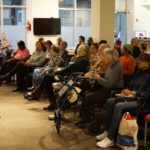 Older people aren’t perhaps the first you think of when it comes to innovation, yet a recent study from Penn State highlights the crucial role they can play in local innovation.
Older people aren’t perhaps the first you think of when it comes to innovation, yet a recent study from Penn State highlights the crucial role they can play in local innovation.
Indeed, the research found that older adults often lead the way in terms of innovation, because they can combine their extensive knowledge with unheralded levels of creativity to revitalize their local communities.
“The idea behind the project is how we can reframe old age as a time when people can contribute and have capacity and are valuable and creative,” the researchers explain. “It is very different from the traditional way of looking at aging, which is to see people as they age as requiring custodial care, becoming things that we need to take care of. We think that’s wasteful and, as old age becomes a longer period of time and as more people are in that phase of life, it’s just sensible to explore how older adults can do more and be more.”
Innovative seniors
One community that aims to tap into this creativity and wisdom is Senior Planet, a community that aims to help residents ‘age with attitude’. From the outside, it looks just like the kind of co-working spaces you see dotted around the world, with the only difference being that the young hipsters are replaced with old entrepreneurs.
Members get a range of tech-related classes, and support in putting their skills to good use in the labor market. Classes range from using social media to processing payments for their new website. Many open businesses aimed at the older market, with the shorter horizon acting as a key motivator behind their efforts.
This kind of project is especially important because research a few years ago highlighted the age-related biases people have when it comes to innovation and entrepreneurship. The study found, across three different experiments, that people are more likely to perceive younger looking people as innovative and creative, whereas their older looking colleagues are more likely to be viewed as stable and conservative.
A second study, from the University of Kent, highlights how these negative stereotypes impact older people in the labor market. They found that the performance of older workers is affected by the stereotypes they encounter in the workplace, whether those stereotypes are merely perceived, or indeed even situations that remind them of stereotyping in their past.
They discovered that this negative impact was particularly pronounced when the threat was induced by stereotypes rather than by facts.
The health impact of ageism
The scale of the challenge was emphasized by a recent study from Yale School of Public Health, which estimated that the cost of ageism could reach up to $63 billion, just in terms of health costs in the United States alone.
The work is believed to be the first of its kind to quantify the health costs associated with ageism. Indeed, they found that ageism was responsible for some 17 million cases of the eight most expensive health conditions in just a single year.
“Ageism is one of the least visible prejudices,” the authors explain. “Our study helps to increase the visibility of ageism by looking at its consequences.”
As society ages, it’s vital that we ensure older people remain active and valued members of society. Projects like Senior Planet are vital in pushing past the many stereotypes and biases that currently hold older people back from deploying their numerous talents across society. It’s clear that many more projects of this ilk are required.